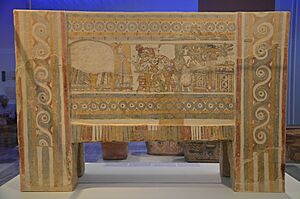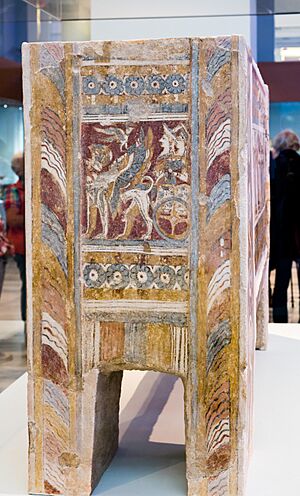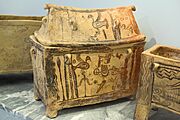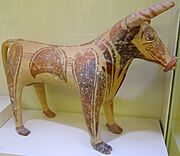Hagia Triada Sarcophagus facts for kids
Quick facts for kids Hagia Triada Sarcophagus |
|
|---|---|
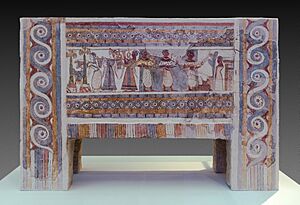 |
|
| Material | Limestone |
| Size | length: 137 cm |
| Created | c. 1400 BC |
| Discovered | 1903 Faistos, Crete, Greece |
| Present location | Heraklion, Crete, Greece |
The Hagia Triada Sarcophagus is a special stone coffin from the ancient Minoan civilization. It was made around 1400 BC and is about 137 centimeters (54 inches) long. This sarcophagus was found in 1903 in a tomb at Hagia Triada on the island of Crete, Greece. Today, you can see it at the Heraklion Archaeological Museum in Crete.
What makes this sarcophagus so unique is that it's covered in plaster and painted with colorful pictures using a technique called fresco. Usually, Minoans only used frescoes to decorate their palaces and homes, not for burials. This is the only limestone sarcophagus from its time that has been found. Most other burial chests from that era were smaller, made of clay, and painted much more simply. The Hagia Triada Sarcophagus is also special because it shows detailed scenes of Minoan funeral ceremonies. It was likely used for the burial of an important person, perhaps even a prince.
This sarcophagus gives us a lot of information about ancient burial customs when Crete was ruled by the Mycenaeans. It mixes styles from both the Minoan and Mycenaean cultures, and even shows some ideas from Ancient Egyptian religion.
Contents
What Does the Hagia Triada Sarcophagus Look Like?
All four sides of the sarcophagus are beautifully painted with many colors. The artists used the fresco technique, which means they painted on wet plaster. This is the same way Minoans painted their palace walls, floors, and ceilings.
Each of the two long sides shows a detailed story about religious ceremonies. One of the short ends has a picture of a chariot with two figures, possibly goddesses. This is because their chariot is pulled by a griffin, a mythical creature. A large bird hovers above them. The other short end has two scenes. The top one is mostly missing, but it probably showed men walking in a procession. The bottom scene on this end shows two figures in a chariot pulled by two horses.
The painted scenes are surrounded by decorative borders. These borders look like the ones found on Minoan wall paintings, but they are larger compared to the figures. The decorations include swirls, stripes, and rows of rosettes. There are also thin white strips above and below the main scenes on the long sides. Some parts of the scenes even extend into these strips. Unlike other Minoan burial chests called larnakes, this sarcophagus does not have a lid, and it seems it was never meant to have one. It also has small holes for drainage.
What Stories Do the Paintings Tell?
The long painted scenes on the sarcophagus show different parts of a special ceremony. This ceremony was likely performed when an important person was buried.
The Bull Sacrifice Scene
On one of the long sides, there is a scene showing a bull being sacrificed. The bull is tied down on a table-like altar. Under the altar, there are at least two smaller animals, which might be calves, deer, or goats. They could be clay models, or real animals waiting to be sacrificed. Behind the altar, a man is playing a double flute called an aulos. He is painted red, which was how Minoan artists usually showed men. Women were painted white.
To the left of the bull, five women are facing the altar. The first woman is complete and wears a large crown with long feathers. She holds her hands out with open palms. This part of the scene has a yellow background, which changes to white near the altar. Blood from the altar table is pouring into a bucket or a special cup called a rhyton.
In the last part of this scene, the background color changes to a muddy blue. A woman wearing a shaggy animal hide skirt or apron faces away from the bull. She holds out her arms over a bowl on a stand or altar. Next to her, a decorated vase and a bowl with round fruit-like objects seem to float in the air. In front of this, there is a pole with a labrys (double axe) on top, and a black bird sitting on the axe. This pole has a checkered base, which might be a step leading to the final element. This last part is either another altar or a building, possibly the tomb itself. It has four Horns of Consecration symbols and a tree on top. Both the structures in this scene have decorations like spiral swirls and stripes, similar to the borders on the sarcophagus.
The Offering Scene
The other long side of the sarcophagus also tells a story and is divided into three sections with different background colors. On the left, with a white background, three figures face left. First, a woman in a hide skirt is pouring liquid from a decorated vase into a large metal cauldron. This liquid might be blood from the sacrifice on the other side, perhaps offered to the spirit of the person who died. The cauldron sits on a tripod between two poles. These poles have labrys symbols and a bird on top of each. Behind the first woman, another richly dressed woman with a crown carries two vessels on a yoke over her shoulders. Behind her, a man in a long robe plays a seven-string lyre. This is the oldest known picture of a lyre in Greece! This scene reminds us of ancient stories where the dead needed blood.
In the middle section, with a blue background, three men wearing hide aprons or kilts face right. They are carrying models of animals (probably bulls) and a boat. They seem to be walking towards the only figure in the right-hand section, which has a white background. This figure is a man standing still, without arms or feet, wearing a long cloak made of animal hide with gold edges. It is believed that he represents the dead person, receiving gifts. The boat might be for his journey to the afterlife. The dead man stands outside what looks like the fancy entrance to his tomb, next to a tree and three steps.
How Old is the Hagia Triada Sarcophagus?
Newer excavations at the same site helped experts figure out the exact age of the sarcophagus. It is now believed to be from between 1370 and 1320 BC. This time period matches the end of the 18th Dynasty in Egypt. During this era, Crete and Egypt had a lot of contact. This connection helps us understand how the painting techniques and art styles on the sarcophagus might be similar to those found in Egyptian temples and tombs.
Small sculptures found in other parts of Crete from this time also show connections to honoring the dead. While funeral rituals were not very common in Crete, they did happen for important people like kings or high officials.
What Do the Symbols Mean?
Experts like Nanno Marinatos have studied the symbols on the sarcophagus. She believes that Minoan society was led by a royal couple, a priest-king and queen, who had both political and religious power. The queen might have been more important in religious ceremonies. Marinatos suggests that the hide skirt worn by some figures shows their close involvement in sacrifices and offerings. She thinks the same royal figures are shown more than once on the sarcophagus, especially the queen. The queen is shown in a long robe and feathered crown, and then later in a hide skirt when performing ceremonies.
In Minoan art, the feathered crown is usually worn only by gods, griffins, and the queen, who was also the chief priestess. The king is only shown wearing the hide skirt. This idea is supported by similar practices in other ancient cultures, where priest-royalty changed clothes to show a change in their roles.
The sacrifice scene might be understood by looking at how ancient Greeks worshipped two types of gods:
- Ouranioi: Gods of the heavens.
- Chthonioi: Gods of the earth.
The position of the worshipers' hands (palms down) and the low altar suggest that the sacrifice is for a chthonic (earth) deity. This deity might appear as the black bird on the baetylus (a sacred stone) behind the low altar. The black color is also linked to chthonic gods. The bull's throat is pointing down, which also means the sacrifice is for an earth deity.
The high altar is for the ouranioi (heavenly gods). Above the low altar, there is a jug of water and a basket of fruits. The water is for purifying the people taking part in the sacrifice. In ancient Greece, offering fruits of the earth was also done for chthonic deities. On the high altar, there are Horns of Consecration and a tree with seven branches. The horns of consecration are often found in high places in Minoan religious art, suggesting they relate to heavenly gods. The tree, with its seven branches, might represent new life, and the number seven was important in Egyptian culture, meaning completeness.
There are seven people in the sacrifice scene with their hands down, palms down. This might show a strong prayer to the earth deity. The scene also includes a pipe player, incense, and a jug of water for purification, which were common in ancient Greek sacrifices. The sacrifice likely happened at night because rituals for earth deities usually took place at night, while rituals for heavenly gods happened during the day.
The offering scene also has seven participants, making the offering powerful. The two golden birds on baetyls (sacred stones) sitting on double axes are the highest objects in the scene. This means they are gods appearing in bird form. The blood from the sacrifice scene seems to turn into water in the offering scene. This "water" is given to the "thirsty dead," as mentioned in ancient texts. The dead person (the lowest figure) receives this "water" as nourishment because the dead were thought to feed on liquids, not solid food. So, the calves are symbolic food for the dead. The stairs in front of the dead man's tomb, an idea from ancient Egypt, allow the spirit of the dead man to rise into the world of the living. In ancient Egypt, a tree on a sarcophagus also represented new life.


